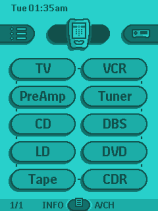|
...Continued from Page 3.

The Pronto's Main Menu. |
With or without a computer, you can still get it done.
The Pronto provides a choice of two programming methods. First is using the basic remote. You can create macros, learn signals, delete or add buttons in predefined positions, add devices and more. The second is via ProntoEdit, in which you can create totally custom setups with buttons, macros, downloaded commands off the Internet and much more. First, we'll cover the basic remote method.
The Pronto uses a simple graphical interface for navigation with three main sections. First is the "Home Menu" where a listing of all devices is stored. When operating a device you can return to the "Home Menu" simply by pressing the house-shaped button at the top of the screen. The other two sections are accessed just below the [HOME] button on the device bar. To the left is the "Macro Menu", to the right the "Device Menu". Although these distinct sections become a moot point under ProntoEdit, they're of importance when programming on the remote by itself as macros can only be stored under the Macro Menu, and learned codes only under the Device Menu. At the bottom of the screen is a thin bar with labels for the two lower hard buttons, plus a "Mode Menu" in the middle through which all programming is accomplished.
Back to the "Home Menu". At the top center is an icon of the Pronto. Holding it down enters the "Setup Menu" where all advanced system configuration settings are stored. Each "Home Menu" page can hold 10 devices - but since there can be multiple pages there's no real minimum or maximum to the number of controllable components - you're only limited by available memory. "Unlimited devices"… that rolls off the tongue nicely, yes?
The best of both worlds...
The original TS-1000 model was one of only a few "fully learnable" remotes to be available at the time. What this means is that each and every button on the Pronto can hold a signal captured off of an original equipment remote. Learning remotes are the most powerful, since they can essentially control any function of any device. But the fatal flaw with the whole concept of "learning only" is that folks with lost or broken remotes couldn't use the Pronto to replace their missing ones. The TS-1000 did have a few built-in codes, but they were only for Philips or Magnavox components - which is, needless to say, far from adequate. Configurations uploaded from other users could be downloaded and installed through ProntoEdit, but what if the owner had no computer or Internet connection, or no one else has posted a similar device?
Realizing that this was a serious problem that warranted attention, Philips decided that starting with the TSU-2000 they needed to include a full database of preset codes. Instead of creating such a database by themselves, or using the limited one that Philips had developed for their other "lower end" remote products, the Pronto team went right to the very top - to the "reigning king" of infrared commands, Universal Electronics (UEI). Their database is well-known as the most comprehensive available, with a neat and orderly listing of hundreds of device brands.
| 
